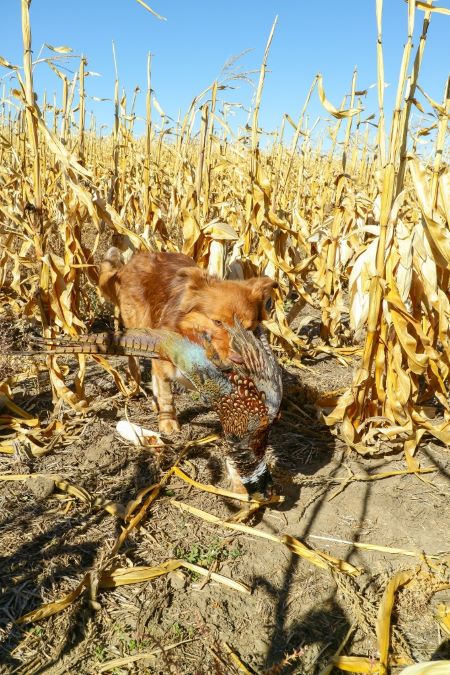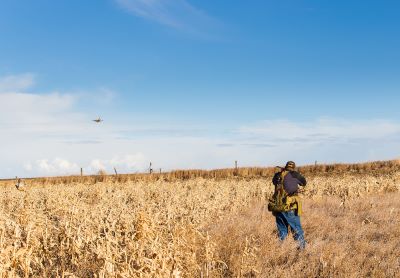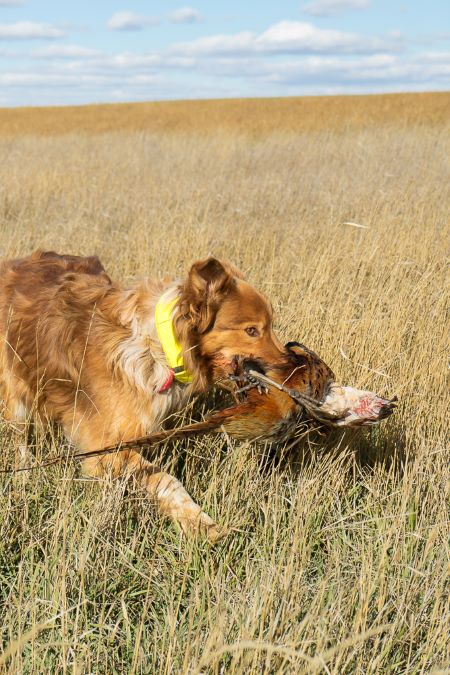How One Man in the Field Figured Out How to Block for His Dogs
Article and photos by Garhart Stephenson
Over the years a seasoned pheasant hunter tends to pick up on a few concepts considered more than useful. The “poor man’s driven bird shoot” is one of the more endearing. Unlike a real driven shoot, this is ideal for the lone sportsman. But what about the “beaters” A well-trained flushing dog fills the requirement nicely. Our method involves pushing difficult to approach pheasants into some form of heavy cover and letting pup do the bulk of the chasing. Cattail marshes along lakeshores are tailor-made for this endeavor, as are standing crops planted in long strips, provided they are not too broad. This also is an avenue to hunt said crops in areas where it is not legal to hike through them prior to harvest. Creek bottoms or tumbleweed patches can also play out well.
The athletic part comes once the dog locks in on scent like a pair of vice grips. Now is the time to hustle ahead to some bottleneck in the cover and block for your pooch. Staying out of sight when moving ahead is imperative to this ruse. Doing so keeps pheasants from realizing trouble waits ahead and helps keep the dog from breaking focus for the purpose of rejoining its master. The dog must maintain pursuit and the roosters can’t be aware of your presence, or the whole thing falls apart. The frenzy at the end is quite invigorating and there is no concern of anyone’s stray shot flying your direction.

It’s been quite a number of years since I first used this trick along a cattail lined lakeshore…three Border Collies ago.
I was befuddled as roosters streaked through tall Conservation Reserve Program (CRP) cover on trails beat down by deer and sportsmen. The place had turned into an autobahn for pheasants. Any foot race resulted in the obligatory wild flush. Any slow tactics resulted in birds just running further ahead. Most frustrating. An entire swarm of birds had thus far eluded us, save for one that erupted in my direction, a poor choice of evasive maneuvers. The rest scattered like marbles on a playground during recess. The bulk of those marbles settled into cattails along the lake.
A blocker was needed and I had no such luxury. My buddy was busy hauling corn. That’s when the epiphany struck like lightning. Why couldn’t I trot ahead to the next cove, point, or bottleneck? The dog certainly did not require my help in pushing paranoid birds downrange. “It’s so crazy it has to work!” The freshly hatched scheme festered to a rapid boil in my mind.
The stage was set for a grand experiment. Would it end in a blaze of glory or ignominious defeat?
Upon reaching the cattails, two things were evident. Katie had plenty of scent to work and pheasant feet were once again gobbling up ground like a Hemi Charger. I needed to get moving, NOW! These pheasants were well aware of our unfriendly intentions. Once Miss Kate had a lock on interwoven scent trails, I silently slipped out onto the frozen shoreline and made tracks for a tight bottleneck some two hundred yards distant. If I hustled, I could settle in quietly and wait with gun at port arms.

Soon, a frenzied noise of scurrying pheasants, rustling through the crisp, dry stalks met my ears. In close proximity, collar tags played their tinkling symphony. Closer, closer it came; out popped a hen. My heart raced. Then a rooster burst out and the fuse was lit! These first escapees chose to exit back toward the shimmering golden landscape of CRP, an intense rush of wings pouring into the azure sky between Kate and myself. Total and complete surprise!
The big moment had arrived. It was one of those moments that play back through a seasoned hunter’s dreams, frame by frame, frozen in eternity. Over a dozen birds now hung in the sky, long tail feathers twisting and warping under the force of beating wings and prairie winds. I selected a magnificent rooster from the fray and blotted out the ascending form. This rooster tumbled while I swung toward another now crossing hard from right to left. The second barrel now spent, my quarry veered off into the distance, victorious.
There was no time to ponder such things; once gunfire broke out, every bird took flight in one mad rush. I suddenly found myself desperately stuffing a fresh pair of #5’s into the chambers as at least fifty birds rose in all directions above the whirling dog, close. It’s funny how fast they look when the gun is mounted, yet they appeared like a squadron of tethered balloons while I did my best to cram those cartridges into place without including my thumb in the deal. As the gun closed, I faced a dilemma of “choice.”

One lonely bird is fairly simple to pick out against an empty sky; isolating one quickly amongst a large group actually requires concentration. I was running the risk of completely unraveling in the heat of battle. Scientists refer to the situation as “predator confusion.” I call it good old-fashioned panic. My brain finally decided to override the adrenaline and separated a proper opportunity. In a flash, a cluster of #5’s hurtled ahead toward this escaping bird. The moment sealed; feathers now gently drifted past on air currents as I opened the firearm to enjoy the delightful essence of spent gunpowder. Katie busied herself seeking out each fallen prize. I stooped to pick up the pair of empties deposited at my feet from the first volley. I had just reveled in the aura of a driven bird shoot, minus the beaters, loader, and expense; not quite the well refined event that takes place on the other side of the pond, but I could get used to it.

Utilizing this premise in standing corn also salvaged my final hunt in North Dakota one season. My friend Mike from Gillette, Wyoming, and I were hunting a familiar property which had been kind to us recently. We intended to stick around a few more days but the weather forecast had turned dire. Snow, high winds, and temperatures beyond -20 fahrenheit were to move in by sunset. Mike is a pilot and was scheduled to fly a group of people to some distant locale in a few days; he could not afford to be stranded. After a relatively lackluster morning hunt, I stated that the landowner’s son had mentioned a strip of corn downstream. This plot had not been hunted in a while. Mike was understandably concerned with changing meteorological conditions. I too had important obligations waiting at home and could not allow myself to become stuck in North Dakota. The final two days of my license would go unused. But I was not going down without a fight. Snow was to begin falling in the coming hours and the attempt to coerce my hunting partner to remain any longer was in vain. “It could be a quick hunt, Mike. No one has been in there lately.” Mike acknowledged the possibility, yet headed back to break camp.

I predictably, did not. It is in my nature to make such decisions, especially when there is confidence in an idea and my dog. Mike would have been the blocker, but without him, I was back to “block for the dog.” Katie no longer with me, it was now Rusty’s turn.
We soon found ourselves alone in an ideal situation. The cornfield was a long narrow strip perhaps thirty yards wide and a quarter mile in length. The eastern boundary filtered out into a large expanse of barren pasture. The CRP on the western border had been mowed in strips and a streambed lie at the far end. Any pheasants boosted from the standing corn would head there or flush across the open in an attempt to reach the tall grass.
Hundreds of pheasant feet had visibly trampled the crop edge. “Oh boy!” I reeled with the anticipation of a child on Christmas morning. The only problem was how to keep track of Rusty, then I remembered the bell in my gear box.

The plan consisted of cutting Mr. Rusty loose with a bell attached to his collar and give him free reign. Rather than run to the end to block, the ruse seemed better executed by taking advantage of his vigor…and the brass noise maker hanging from his collar. It would draw the bird’s attention away from me and let me adjust my position effectively.
Immediately Rusty picked up emanations of game afoot and this set the dominoes to falling. I scrambled around the corner and kept slightly ahead of that tinkling bell; ready for the first cockbird to burst out for sanctuary.
The melody of Rusty’s bell was joined by a clattering of wings and the staccato of a rooster’s cackle. Several birds violently climbed from the pale shafts of corn, crossing in front of the scattergun. It was too late for them to abort their mission. I brought up the paired barrels with full intention of cancelling the flight of a nearby ringneck. The percussion section was about to join the concert. A robust rooster tumbled. As I replaced the spent hull, Rusty enthusiastically approached with the cock. Bird stowed; the order was given: “Go get ‘em!”
Rusty eagerly resumed his harassment of these corn dwellers. The brass chime beneath his neck aided my ability to maintain proper position and it was producing plenty of audible preludes. Roosters may be quick, but as long as they remained earthbound, he would overtake them. Once the gap was breached, a total melee broke out. Pandemonium! A mass “free-for-all”. Roosters poured into the prairie sky. I merely had to choose a pair and swat them each with a dose of #5 shot. Simple enough, but I have been known to blow the opportunity, ad nauseum.
Regaining my composure, I somehow managed to take one, then locate another. The first shot put an old longspur beak down. After what seemed an immense period of time, the bead at the end of the barrel was pulling past another fleeing cockbird. In reality, the entire episode took mere seconds. A quick tap of the trigger gave permanent resolution. As the bird came to a halt in the bare strip that lay between corn and safety, pheasants continued to fill the heavens. Rusty came to my aid by retrieving a brace of North Dakota’s finest.
Cradling the last warm bird in my hand, I marveled at how the sunlight played off its iridescence. The end of any hunt has a sense of finality, but this was really it, the goal line had been crossed. In the distance darkening skies foretold of the approaching storm. I would now drive into nearly five-hundred miles of unknown. Time to go, the bittersweet moment in time when one realizes that the show is over and the exits are clearly marked. I kneeled down and hugged Rusty like a child. I also reflected on the years Katie provided me. Every ending leads toward another beginning. A month of travels had concluded. I removed Rusty’s bell and held in hand. It announced many great events during recent minutes, and now it chimed one more: time to go, the closing bell. We turned into the wind and headed west.
Upon entering Wyoming, I called Mike to check road conditions ahead, he was twenty miles behind me. With a smile I knew he could not see, I relayed the events: “You should have stayed”…
Garhart Stephenson is an avid outdoorsman residing in west central Wyoming. Throughout the year he is typically outdoors with rod or gun in the company of his faithful dogs.

Garhart Stephenson is an avid outdoorsman residing in west central Wyoming. Throughout the year he is typically outdoors with rod or gun in the company of his faithful Border Collie, Rusty.


Comments